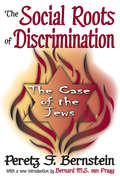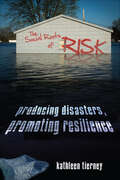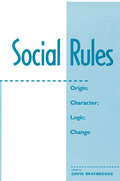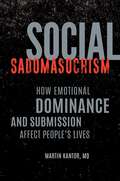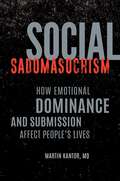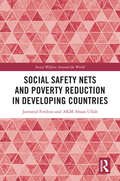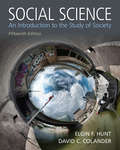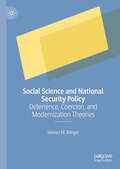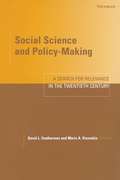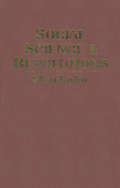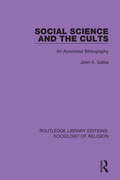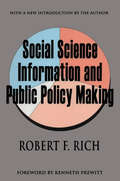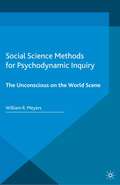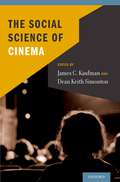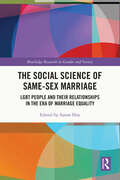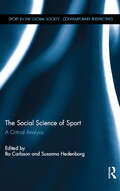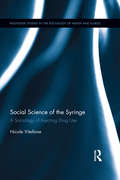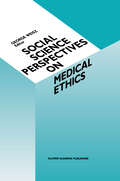- Table View
- List View
The Social Roots of Discrimination: The Case of the Jews
by John W. ThibautThe Social Roots of Discrimination explains the phenomenon of anti-Semitism. In this classic volume, Peretz F. Bernstein looks for objective reasons why anti-Semitism flourished in European countries. Some civilized people would consider the notion of race uncivilized, but the existence of different races and the inequality of races with their specific race characteristics and on top of that the existence of superior and inferior human races was accepted as a fact of life and as a scientific truth long before the Nazis came to power. Although there is a marked difference in dealing with anti-Semitism in continental Europe in 1920 and the anti-Semitism in, for instance, the US in 2000, Berstein's ideas remain valuable.Starting from a concrete problem, anti-Semitism in Central Europe, Bernstein puts anti-Semitism in a general sociological theoretical framework. Far from limiting himself to fruitless elaborations on the common perceived unpleasant characteristics of Jews, he recognizes that the group is heterogeneous and that the usual arguments to justify anti-Semitism do not have any general validity, although they may hold for some specific individuals of the hated group, like individual members of any group may be less pleasant. Bernstein's ideas remain valuable.Bernstein tries to explain the hatred of Jews as the working of a more general mechanism--one that has nothing to do specifically with of Jews as a collective or as individuals. In doing so Bernstein attempts to sketch a general theory of social groups and conflicts between groups. The Social Roots of Discrimination gives an important message both for social scientists and for all intellectuals who are concerned with the strifes between nations, races, and social groups.
The Social Roots of Risk: Producing Disasters, Promoting Resilience (High Reliability and Crisis Management)
by Kathleen TierneyThe first decade of the 21st century saw a remarkable number of large-scale disasters. Earthquakes in Haiti and Sumatra underscored the serious economic consequences that catastrophic events can have on developing countries, while 9/11 and Hurricane Katrina showed that first world nations remain vulnerable. The Social Roots of Risk argues against the widespread notion that cataclysmic occurrences are singular events, driven by forces beyond our control. Instead, Kathleen Tierney contends that disasters of all types—be they natural, technological, or economic—are rooted in common social and institutional sources. Put another way, risks and disasters are produced by the social order itself—by governing bodies, organizations, and groups that push for economic growth, oppose risk-reducing regulation, and escape responsibility for tremendous losses when they occur. Considering a wide range of historical and looming events—from a potential mega-earthquake in Tokyo that would cause devastation far greater than what we saw in 2011, to BP's accident history prior to the 2010 blowout—Tierney illustrates trends in our behavior, connecting what seem like one-off events to illuminate historical patterns. Like risk, human resilience also emerges from the social order, and this book makes a powerful case that we already have a significant capacity to reduce the losses that disasters produce. A provocative rethinking of the way that we approach and remedy disasters, The Social Roots of Risk leaves readers with a better understanding of how our own actions make us vulnerable to the next big crisis—and what we can do to prevent it.
Social Rules: Origin; Character; Logic; Change
by David BraybrookeThis collection is a pioneering effort to bring together in fruitful interaction the two dominant perspectives on social rules. One, shared by philosophers, lawyers, anthropologists, and sociologists, directly invites formalization by a logic of rules. The other, originating with economists, emphasizes cost considerations and invites mathematical treatment, often in game-theoretical models for problems of coordination?models that some philosophers have taken up as well.Each perspective is represented by new and recent work that moves this important topic toward increased conceptual precision and deeper insight. As a whole, the collection strikes a balance between historical illustrations and theoretical argument, offering in both a rich body of suggestions for further work.
Social Sadomasochism: How Emotional Dominance and Submission Affect People's Lives
by Martin Kantor MDExplains the subtle but pervasive aspects of sadomasochism that affect everyday relationships across our lives, detailing when the power and control dynamics become neurotic and describing actions that can be taken to better individuals and improve society.For most people, a whip-wielding, leather-clad sexual subculture comes to mind when they hear the phrase "sadomasochism." But as psychiatrist Martin Kantor explains in this book, sadomasochism is generally about power, control, dominance, and submission, dynamics that are subtle and pervasive in all of our lives, from home life to work life to social interactions including political arenas. The bottom line: sadomasochism is about the giving or receiving pleasure from the infliction or reception of pain or humiliation and both pain and pleasure can be purely emotional, no sexual or physical context necessary. Kantor deconstructs sadomasochism to show us how it affects each of us, consciously or not. He explains the "life phases" of sadomasochism, the role early trauma plays in this self-defeating action when it reaches a neurotic level, and the damage it does to individuals, loved ones, and society. This ground-breaking book will appeal to psychology students and researchers, as well as general readers with an interest in psychology.
Social Sadomasochism: How Emotional Dominance and Submission Affect People's Lives
by Martin Kantor MDExplains the subtle but pervasive aspects of sadomasochism that affect everyday relationships across our lives, detailing when the power and control dynamics become neurotic and describing actions that can be taken to better individuals and improve society.For most people, a whip-wielding, leather-clad sexual subculture comes to mind when they hear the phrase "sadomasochism." But as psychiatrist Martin Kantor explains in this book, sadomasochism is generally about power, control, dominance, and submission, dynamics that are subtle and pervasive in all of our lives, from home life to work life to social interactions including political arenas. The bottom line: sadomasochism is about the giving or receiving pleasure from the infliction or reception of pain or humiliation and both pain and pleasure can be purely emotional, no sexual or physical context necessary. Kantor deconstructs sadomasochism to show us how it affects each of us, consciously or not. He explains the "life phases" of sadomasochism, the role early trauma plays in this self-defeating action when it reaches a neurotic level, and the damage it does to individuals, loved ones, and society. This ground-breaking book will appeal to psychology students and researchers, as well as general readers with an interest in psychology.
Social Safety Nets and Poverty Reduction in Developing Countries (Social Welfare Around the World)
by Jannatul Ferdous AKM Ahsan UllahThis book investigates the origins, current state, and fundamental value of social safety nets in developing countries, as well as their effectiveness in these settings. Social safety net programs (SSNPs) are critical because they keep those who are already vulnerable from falling deeper into poverty. Analysing how social safety nets benefit the most disadvantaged and marginalized members of society by allowing those in need to become financially stable, more resilient, and open up more opportunities for themselves, this book shows that social safety nets (SSNs) are a collection of social services designed to protect people from the effects of economic and emotional hardship. Showing that the purpose of the safety net is not to provide permanent financial security, but rather to provide temporary financial security during periodic shocks and how this applies in South Asia and also in parts of Africa, this book will be of interest to all scholars and students of social policy, sociology, social work, and Global South politics more generally.
Social Safety Nets and Poverty Reduction in Developing Countries (Social Welfare Around the World)
by Jannatul Ferdous AKM Ahsan UllahThis book investigates the origins, current state, and fundamental value of social safety nets in developing countries, as well as their effectiveness in these settings. Social safety net programs (SSNPs) are critical because they keep those who are already vulnerable from falling deeper into poverty. Analysing how social safety nets benefit the most disadvantaged and marginalized members of society by allowing those in need to become financially stable, more resilient, and open up more opportunities for themselves, this book shows that social safety nets (SSNs) are a collection of social services designed to protect people from the effects of economic and emotional hardship. Showing that the purpose of the safety net is not to provide permanent financial security, but rather to provide temporary financial security during periodic shocks and how this applies in South Asia and also in parts of Africa, this book will be of interest to all scholars and students of social policy, sociology, social work, and Global South politics more generally.
Social Science: An Introduction to the Study of Society -- Pearson eText
by Elgin F. Hunt David C. ColanderSocial Science, 15/e, approaches social science from a common-sense perspective, rather than from a conventional social science angle. Readers will see how seemingly diverse disciplines intermingle – anthropology and economics, for example. In the end, students will be able to approach social issues with unbiased problem-solving skills.
Social Science: An Introduction to the Study of Society -- Pearson eText
by Elgin F. Hunt David C. ColanderSocial Science, 15/e, approaches social science from a common-sense perspective, rather than from a conventional social science angle. Readers will see how seemingly diverse disciplines intermingle – anthropology and economics, for example. In the end, students will be able to approach social issues with unbiased problem-solving skills.
Social Science and National Security Policy: Deterrence, Coercion, and Modernization Theories
by Janeen M. KlingerThis book examines how deterrence, coercion and modernization theory has informed U.S. policy, addressing why former Defense Secretary Robert McNamara’s famous description of the Vietnam War as the “social scientist’s war” is so accurate. By tracing the evolution of ties between social scientists and the government beginning in World War I and continuing through the Second World War and the early Cold War, the narrative highlights the role of institutions like the RAND Corporation, the Social Science Research Council and MIT’s Center for International Studies that facilitate these ties while providing a home for the development of theory. The author compares and contrasts the ideas of Bernard Brodie, Herman Kahn, Albert Wohlstetter, Thomas Schelling, Gabriel Almond, Lucian Pye and Walt Rostow, among others, and offers a cautionary tale concerning the difficulties and problems encountered when applying social science theory to national security policy.
Social Science and Policy-Making: A Search for Relevance in the Twentieth Century
by David Lee Featherman Maris Arvids VinovskisThis collection of essays examines how the social sciences in America were developed as a means of social reform and later, especially after World War II, as a tool in federal policymaking and policy analysis. It also uses arenas of policymaking, such as early childhood education and welfare and its reform, as case studies in which social research was used, in policy decisions or in setting and evaluating policy goals. The book is written to aid students of public policy to appreciate the complex relationship of information--principally, of social science research--to policymaking at the federal level. David L. Featherman is Professor of Sociology and Psychology, Director and Senior Research Scientist, Institute for Social Research, University of Michigan. Maris A. Vinovskis is Bentley Professor of History, Senior Research Scientist, Institute for Social Research, Faculty member, School of Public Policy, University of Michigan.
Social Science and the Cults: An Annotated Bibliography (Routledge Library Editions: Sociology of Religion #15)
by John A. SalibaThis book, first published in 1990, brings together descriptive, comparative, and theoretical materials on cults and sects in Western culture, focusing on literature published since 1970. A historical section links the rise of the new movements to similar past phenomena in Western culture. Other sections examine the methodology of studying religious movements and the various theories which have been brought to explain them, current studies on traditional sects that are sometimes compared to the new religions, and many studies of individual contemporary cults.
Social Science and the Cults: An Annotated Bibliography (Routledge Library Editions: Sociology of Religion #15)
by John A. SalibaThis book, first published in 1990, brings together descriptive, comparative, and theoretical materials on cults and sects in Western culture, focusing on literature published since 1970. A historical section links the rise of the new movements to similar past phenomena in Western culture. Other sections examine the methodology of studying religious movements and the various theories which have been brought to explain them, current studies on traditional sects that are sometimes compared to the new religions, and many studies of individual contemporary cults.
Social Science Information and Public Policy Making
by Robert F. RichA survey of federal officials reveals the belief that government should make the fullest possible use of social science information-and yet most of the information developed by social scientists winds up in specialized libraries or data banks, where it remains unused. Why don't public officials make greater use of the information social scientists develop? What can social scientists do to ensure that their findings are used? To answer these and related questions, Robert Rich reports the results of a unique experiment designed to facilitate the use of research data by public officials in federal agencies. Rich interviewed both researchers and users of research data over the two-year life of a Continous National Survey (CNS) experiment to discover the extent to which the CNS mechanism was successful and to record the levels and types of use that officials made of the data provided. Rich reveals that factors such as the timeliness, cost, and relevance of data do not guarantee that information will be used. He examines patterns in the actual use of survey data by agency officials and explores key organizational factors, such as the compatibility of information with various bureaucratic interests. He discusses the preoccupation of public officials with bureaucratic issues regarding the ownership and control of information, identifies the incentives that prompt bureaucrats to pass along new information and the government officials' difficulties in developing policies and programs for meeting national needs. Rich notes that studies of knowledge inquiry systems, found in the research literature of many social science disciplines have been dominated by a "rationalistic bias." This "bias" is expressed in terms of the belief that the act of acquiring information will automatically lead to its use, in turn, automatically leading to improved policy or decisions. He contends that empirical studies of how information is actually used do not support the assumptions of rational choice theory. The new chapter also discusses types of information, knowledge, and use; prospects for the development of learning organizations in government; and the politics of expertise. This book will be of interest to social scientists and public policy makers. Robert F. Rich is professor of law and political science at the University of Illinois at Urbana-Champaign. He is also professor in the Institute of Government and Public Affairs, and was the director of that Institute from 1986-1997. He is the founding editor of Knowledge: Creation, Diffusion, Utilization (now Science Communication).
Social Science Information and Public Policy Making
by Robert F. RichA survey of federal officials reveals the belief that government should make the fullest possible use of social science information-and yet most of the information developed by social scientists winds up in specialized libraries or data banks, where it remains unused. Why don't public officials make greater use of the information social scientists develop? What can social scientists do to ensure that their findings are used? To answer these and related questions, Robert Rich reports the results of a unique experiment designed to facilitate the use of research data by public officials in federal agencies. Rich interviewed both researchers and users of research data over the two-year life of a Continous National Survey (CNS) experiment to discover the extent to which the CNS mechanism was successful and to record the levels and types of use that officials made of the data provided. Rich reveals that factors such as the timeliness, cost, and relevance of data do not guarantee that information will be used. He examines patterns in the actual use of survey data by agency officials and explores key organizational factors, such as the compatibility of information with various bureaucratic interests. He discusses the preoccupation of public officials with bureaucratic issues regarding the ownership and control of information, identifies the incentives that prompt bureaucrats to pass along new information and the government officials' difficulties in developing policies and programs for meeting national needs. Rich notes that studies of knowledge inquiry systems, found in the research literature of many social science disciplines have been dominated by a "rationalistic bias." This "bias" is expressed in terms of the belief that the act of acquiring information will automatically lead to its use, in turn, automatically leading to improved policy or decisions. He contends that empirical studies of how information is actually used do not support the assumptions of rational choice theory. The new chapter also discusses types of information, knowledge, and use; prospects for the development of learning organizations in government; and the politics of expertise. This book will be of interest to social scientists and public policy makers. Robert F. Rich is professor of law and political science at the University of Illinois at Urbana-Champaign. He is also professor in the Institute of Government and Public Affairs, and was the director of that Institute from 1986-1997. He is the founding editor of Knowledge: Creation, Diffusion, Utilization (now Science Communication).
Social Science Methods for Psychodynamic Inquiry: The Unconscious on the World Scene
by William R MeyersThis book explains, with case examples, a variety of social science research methods suitable for studying the unconscious components of irrational social and political actions in world affairs, which can be defined as those that are intensely destructive, self-destructive, or extremely bizarre. The book argues that they are driven in part by feelings and fantasies that are outside of conscious awareness. Meyers explores the role of empathy in clinical understanding, as well as the value of exposing assertions to empirical disconfirmation. With a variety of research methods such as survey research, content analysis, and narrative analysis, and case examples such as studies of 'irreal' statements by authoritarian leaders, fabricated newspaper articles and climate change denial, this book sheds light on how to conduct research on psychodynamic matters in a scientifically valid and credible way.
The Social Science of Cinema
by James C. Kaufman Dean Keith SimontonEver since motion pictures first landed on screen, there have been many key questions that the studios and movie watchers have tried to answer. What makes a movie an Oscar winner? How does one movie become a hit and another movie flop? Why do some films earn critical acclaim while other films become critical turkeys or bombs? How do audiences perceive film? What makes a movie resonate with a viewer? Are we unduly influenced by negative behaviors on screen? These questions have spurred debates, discussions, and many theories. Until the last two decades, however, it was quite rare to have the issues approached from a scientific viewpoint. The Social Science of Cinema compiles research from such varied disciplines as psychology, economics, sociology, business, and communications to find the best empirical research being done on the movies, based on perspectives that many filmgoers have never considered. Essays explore such topics as the specific factors that influence whether movies make money, win awards, or flop; how our personality impacts on our viewing preferences; issues of gender inequity on screen; the relationship between visual perception and the way movies are edited; and many more. This book attempts the ultimate act of figuring out the mystery behind the movies - what makes them so memorable to us, what makes them this century's leading works of art, and how this art intersects with the business of making money.
The Social Science of Same-Sex Marriage: LGBT People and Their Relationships in the Era of Marriage Equality (Routledge Research in Gender and Society)
by Aaron HoyShowcasing research from across the social sciences, this edited volume seeks to provide readers with an empirically grounded sense of how many lesbian, gay, bisexual, and transgender (LGBT) people marry in the US and Canada, what their marriages look like, and how LGBT people themselves are impacted by marriage and marriage equality. Prior to marriage equality, lawmakers and activists across the political spectrum debated whether same-sex couples should have the legal right to marry, and likewise, academic research to date has focused mostly on the politics of same-sex marriage. However, this edited volume focuses on LGBT people themselves and their intimate relationships in the era of marriage equality. Including both quantitative and qualitative social science research, it features 14 primary chapters that examine a diverse set of topics, including demographic patterns in same-sex marriage and cohabitation, marital aspirations and motivations among LGBT people, arrangements and dynamics within same-sex relationships, and the legal benefits and informal privileges associated with marriage. The edited volume will be of interest to scholars across a wide range of disciplines, including sociology, psychology, child and family studies, communications, social work, and economics, while also offering valuable information for laypeople generally interested in families and/or LGBT studies.
The Social Science of Same-Sex Marriage: LGBT People and Their Relationships in the Era of Marriage Equality (Routledge Research in Gender and Society)
by Aaron HoyShowcasing research from across the social sciences, this edited volume seeks to provide readers with an empirically grounded sense of how many lesbian, gay, bisexual, and transgender (LGBT) people marry in the US and Canada, what their marriages look like, and how LGBT people themselves are impacted by marriage and marriage equality. Prior to marriage equality, lawmakers and activists across the political spectrum debated whether same-sex couples should have the legal right to marry, and likewise, academic research to date has focused mostly on the politics of same-sex marriage. However, this edited volume focuses on LGBT people themselves and their intimate relationships in the era of marriage equality. Including both quantitative and qualitative social science research, it features 14 primary chapters that examine a diverse set of topics, including demographic patterns in same-sex marriage and cohabitation, marital aspirations and motivations among LGBT people, arrangements and dynamics within same-sex relationships, and the legal benefits and informal privileges associated with marriage. The edited volume will be of interest to scholars across a wide range of disciplines, including sociology, psychology, child and family studies, communications, social work, and economics, while also offering valuable information for laypeople generally interested in families and/or LGBT studies.
The Social Science of Sport: A Critical Analysis (Sport in the Global Society – Contemporary Perspectives)
by Bo Carlsson and Susanna HedenborgIn this book questions about definitions and demarcations of sport science are discussed. Not the least the many normative ideas of sport as good or as bad are problematized in relation to the academic field. These ideas permeate sport science in ways that are not seen in other academic fields like history, sociology or law. In addition, if and if so, in what ways sport science influence social science in general. Does sport science bring new questions in relation to issues like "what makes a society possible" or "what is a human being"?This book was published as a special issue of Sport in Society.
The Social Science of Sport: A Critical Analysis (Sport in the Global Society – Contemporary Perspectives)
by Bo Carlsson Susanna HedenborgIn this book questions about definitions and demarcations of sport science are discussed. Not the least the many normative ideas of sport as good or as bad are problematized in relation to the academic field. These ideas permeate sport science in ways that are not seen in other academic fields like history, sociology or law. In addition, if and if so, in what ways sport science influence social science in general. Does sport science bring new questions in relation to issues like "what makes a society possible" or "what is a human being"?This book was published as a special issue of Sport in Society.
Social Science of the Syringe: A Sociology of Injecting Drug Use
by Nicole VitelloneThis book addresses the history of harm reduction. It evaluates the consequences and constraints, stakes and costs of the policy of needle exchange for the purposes of harm prevention and health research. Vitellone situates the syringe at the centre of empirical research and theoretical analysis, challenging existing accounts of drug injecting which treat the syringe as a dead device that simply facilitates social action between humans. Instead, this book complicates the relationship between human and object – injecting drug user and syringe – to ask what happens if we see the object as an intra-active part of the sociality that constitutes injecting practices. And what kinds of methods are required to generate a social science of the syringe that is able to measure injecting sociality? Social Science of the Syringe develops material methodologies and epistemologies of injecting drug use to enact the syringe as an object of intellectual inquiry. It draws on the methodologies of social anthropology, Actor-Network-Theory, Deleuze’s empiricism and new feminist materialism to move towards materially-engaged knowledge production. This interdisciplinary approach improves understandings of the causes and effects of injecting behaviour and the problem of needle sharing, as well as providing a more robust empirical framework to evaluate the motivations and consequences of drug use and drug policy. This book will appeal to researchers and students interested in the sociology of health and illness, STS, Actor-Network Theory, empirical sociology, medical anthropology, social and cultural anthropology, addiction theory and harm reduction.
Social Science of the Syringe: A Sociology of Injecting Drug Use
by Nicole VitelloneThis book addresses the history of harm reduction. It evaluates the consequences and constraints, stakes and costs of the policy of needle exchange for the purposes of harm prevention and health research. Vitellone situates the syringe at the centre of empirical research and theoretical analysis, challenging existing accounts of drug injecting which treat the syringe as a dead device that simply facilitates social action between humans. Instead, this book complicates the relationship between human and object – injecting drug user and syringe – to ask what happens if we see the object as an intra-active part of the sociality that constitutes injecting practices. And what kinds of methods are required to generate a social science of the syringe that is able to measure injecting sociality? Social Science of the Syringe develops material methodologies and epistemologies of injecting drug use to enact the syringe as an object of intellectual inquiry. It draws on the methodologies of social anthropology, Actor-Network-Theory, Deleuze’s empiricism and new feminist materialism to move towards materially-engaged knowledge production. This interdisciplinary approach improves understandings of the causes and effects of injecting behaviour and the problem of needle sharing, as well as providing a more robust empirical framework to evaluate the motivations and consequences of drug use and drug policy. This book will appeal to researchers and students interested in the sociology of health and illness, STS, Actor-Network Theory, empirical sociology, medical anthropology, social and cultural anthropology, addiction theory and harm reduction.
Social Science Perspectives on Medical Ethics (Culture, Illness and Healing #16)
by G. WeiszMedical or hio- ethics has in recent years been a growth industry. Journals, Centers and Associations devoted to the subject proliferate. Medical schools seem increasingly to be filling rare positions in the humanities and social sciences with ethicists. Hardly a day passes without some media scrutiny of one or another ethical dilemma resulting from our new-found ability to transform the natural conditions of life. Although bioethics is a self-consciously interdisciplinary field, it has not attracted the collaboration of many social scientists. In fact, social scientists who specialize in the study of medicine have in many cases watched its development with a certain ambivalence. No one disputes the significance and often the painfulness of the issues and choices being addressed. But there is something about the way these issues are usually handled which seems somehow inappropri ate if not wrong-headed to one trained in a discipline like sociology or history. In their analyses of complex situations, ethicists often appear grandly oblivious to the social and cultural context in which these occur, and indeed to empirical referents of any sort. Nor do they seem very conscious of the cultural specificity of many of the values and procedures they utilize when making ethical judg ments. The unease felt by many in the social sciences was given articulate expression in a paper by Renee Fox and Judith Swazey which appeared in 1984.
